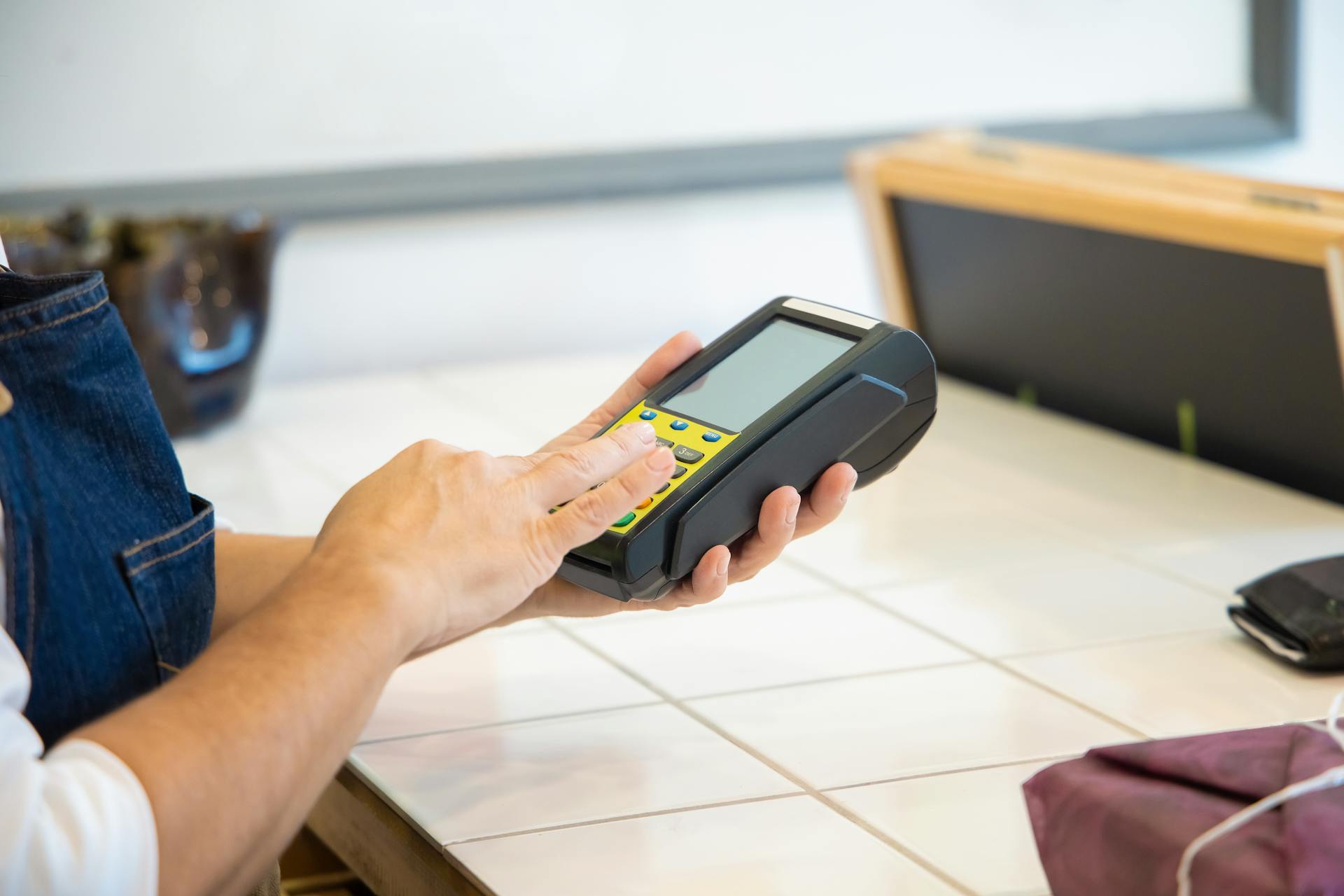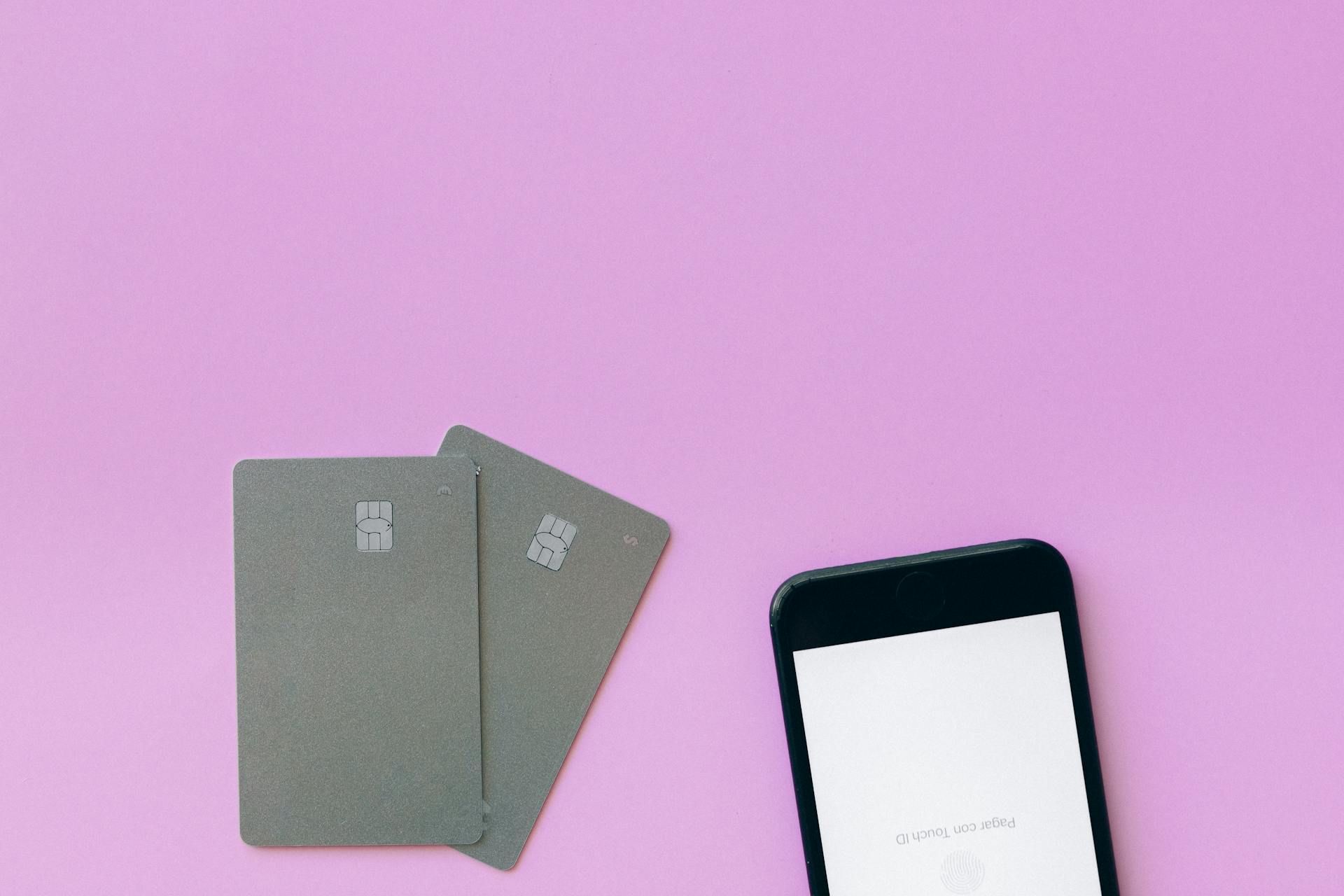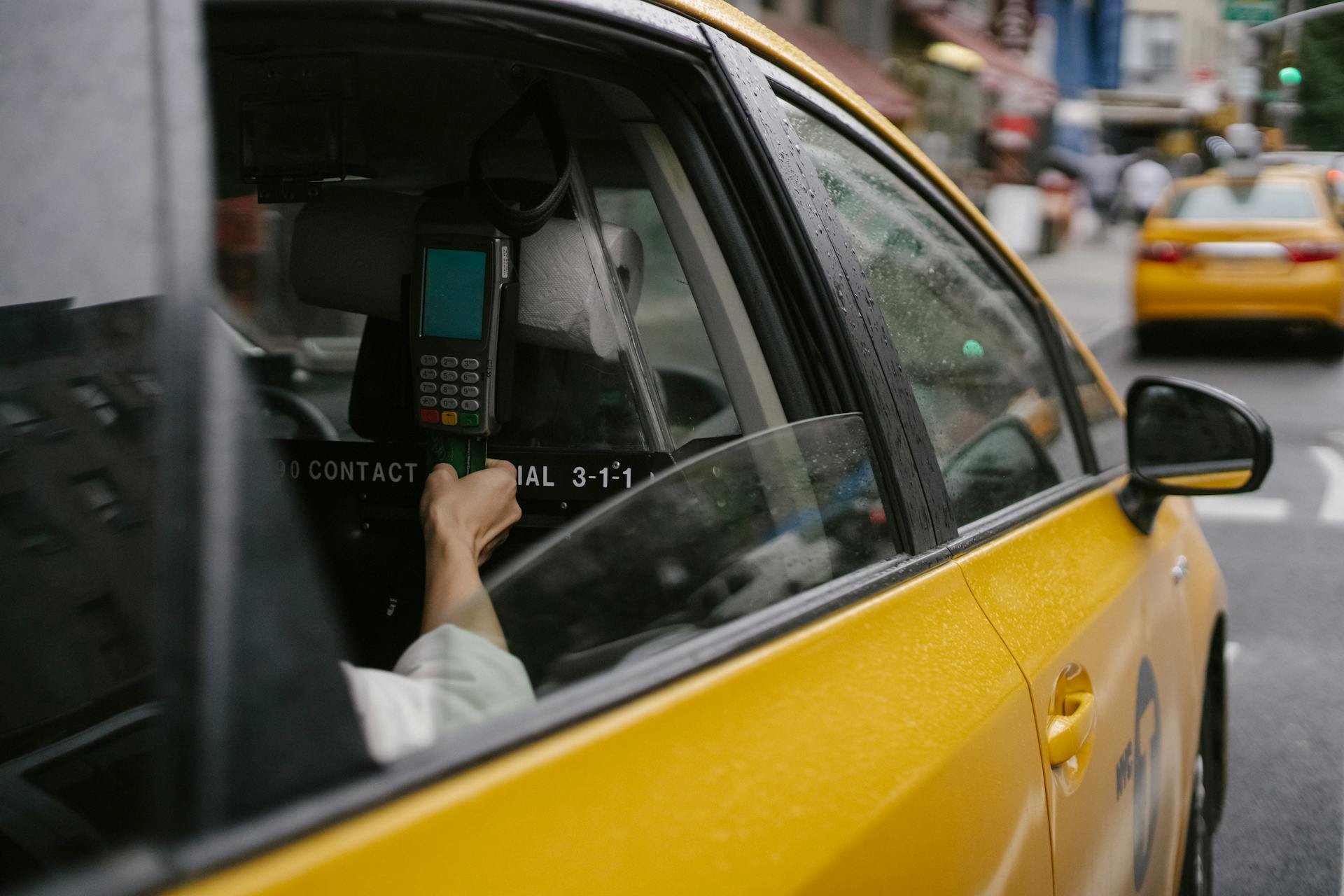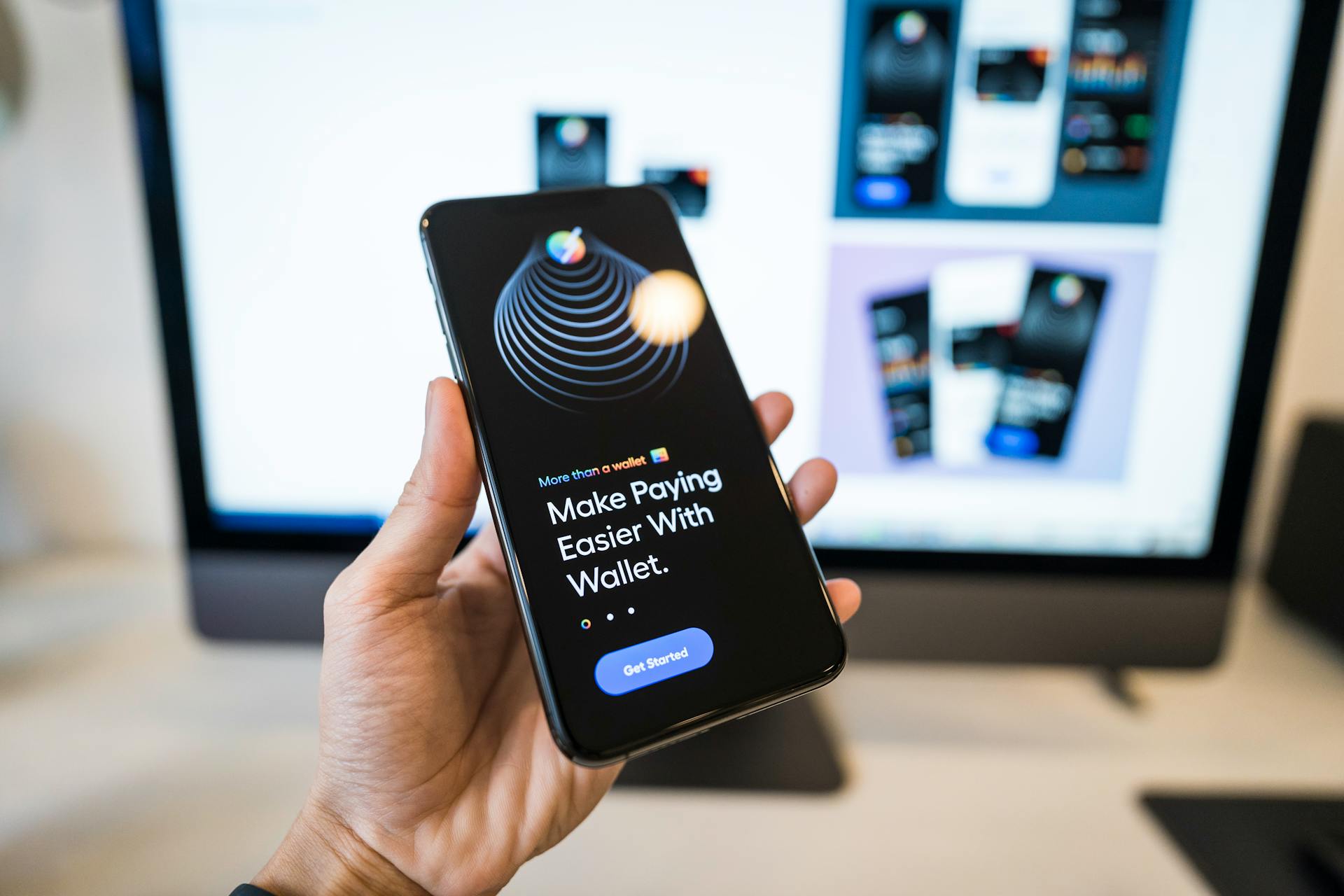
A credit card digital wallet is a convenient and secure way to make payments online or in-store. It allows you to store your credit card information digitally, making it easier to checkout quickly and efficiently.
Digital wallets can be linked to multiple credit cards, making it simple to switch between cards or add new ones as needed. This feature is particularly useful for individuals who have multiple credit cards or prefer to use different cards for specific purchases.
Using a digital wallet can also provide an added layer of security, as it often requires a password or biometric authentication to access the stored credit card information.
For more insights, see: Does Having Multiple Credit Cards Hurt Your Credit
What Is a Credit Card Digital Wallet?
A credit card digital wallet is a financial transaction application that runs on your mobile device. It securely stores your payment information, making it easy to pay for purchases on the go.
You can store your credit card information in a digital wallet, so you don't need to carry your physical cards around. This is especially convenient when traveling or shopping online.
A digital wallet can store more than just your credit card information. It can also store gift cards, membership cards, loyalty cards, coupons, and event tickets.
Here are some benefits of using a credit card digital wallet:
- Quicker payments
- More secure than using physical cards or cash
- Easy to set up and link your credit cards
How it Works
Digital wallets use a mobile device's wireless capabilities like Bluetooth, WiFi, and magnetic signals to transmit payment data securely.
These signals allow your device to connect with the point-of-sale terminal, which is connected to payment processors. This connection is what enables your digital wallet to make a payment.
There are several ways to initiate a payment with a digital wallet, including using QR codes, near field communication (NFC), and magnetic secure transmission (MST).
QR codes are matrix bar codes that store information, which you can use your device's camera to scan and initiate a payment.
NFC is a technology that allows two smart devices to connect and transfer information using electromagnetic signals. This requires the two devices to be close to each other to connect.
Check this out: Earn Money Online with Mobile Phone
MST is primarily used by Samsung mobile phone users and works by generating an encrypted field that the point-of-sale can read.
The card information you've stored in your wallet and choose to use for a transaction is transmitted from your device to the point-of-sale terminal, which is connected to payment processors.
The payment is then routed through the credit card networks and banks to make a payment.
You can use your digital wallet for various transactions, including online shopping, in-store purchases, in-app purchases, and even at some ATMs.
Here are some ways you can use your digital wallet:
- Online: Digital wallets can make online shopping easier by automatically filling in your information for you.
- On the go: Simply tap and pay with your mobile wallet on your smartphone, smartwatch, or other mobile device when you're checking out in a store.
- In apps: Use your digital wallet for easier and more secure in-app purchases.
- At ATMs: You might also be able to use your mobile wallet instead of a physical card at some ATMs.
Types of Digital Wallets
Digital wallets come in many forms, each with its own unique features and capabilities. One of the most well-known digital wallets is Apple Pay, which allows you to add funds to your wallet on your phone or device.
Some popular digital wallets include Cash App, Google Wallet, Samsung Wallet, PayPal, Venmo, AliPay, Walmart Pay, and Vodafone M-PESA. Each of these wallets attempts to distinguish itself from the others with different methods.
Here are some of the most well-known digital wallets:
- Cash App
- Apple Pay
- Google Wallet
- Samsung Wallet
- PayPal
- Venmo
- AliPay
- Walmart Pay
- Vodafone M-PESA
Types of
Digital wallets have become a convenient way to manage our finances, and with so many options available, it can be overwhelming to choose the right one. Apple Pay, Google Pay, and PayPal are some of the most well-known digital wallets out there.
Apple Pay is an example of a digital wallet that allows you to access your financial products through your devices and make purchases. This feature is especially useful for those who want to minimize the need to carry physical cards.
Google Pay, formerly Google Wallet and Android Pay, was born in 2018 and offers an easy way to pay on various websites, within apps, and in stores using cards saved to customers' Google accounts. This digital wallet is widely accepted and has industry-leading security technologies to protect payment information.
There are many other digital wallets available, each with their own unique features and transaction capabilities. Some of the most well-known digital wallets include Cash App, Samsung Pay, Venmo, AliPay, Walmart Pay, and Vodafone M-PESA.
Here's a list of some of the most popular digital wallets:
- Cash App
- Apple Pay
- Google Wallet
- Samsung Pay
- PayPal
- Venmo
- AliPay
- Walmart Pay
- Vodafone M-PESA
Some digital wallets, like Google's, allow you to add funds to the wallet on your phone or device, giving you more flexibility in how you manage your finances.
Add Google Card
Adding a Google Card is a straightforward process that can be done through the Google Wallet app or your bank's app or website. You can access your financial products and make purchases using Apple Pay, which is another example of a digital wallet.
To add a card with the Google Wallet app, follow these steps:
- Open the Google Wallet app.
- At the bottom, tap Add to Wallet.
- Tap Payment cardNew credit or debit card.
- To add a card, use your camera or tap Enter details manually.
- At the bottom, tap Save and continue.
- Read the Issuer Terms.
- Tap Accept.
- If you’re asked to verify your payment method, choose an option from the list.
Alternatively, you can add a card from your bank’s app or website. To do this, follow these steps:
- Open your mobile banking app or go to your bank’s website.
- Log in to your account.
- Tap Add to GPay.
- Follow the on-screen instructions.
If you can’t find the "Add to GPay" button, your card or financial institution may not support this feature. For more details, contact your bank.
Benefits and Drawbacks
Using a credit card digital wallet offers a range of benefits.
You can limit your exposure to financial and personal information by having a digital wallet, which adds security for your credit cards and identification.
Digital wallets can also end the need to carry a physical wallet and cards, allowing you to carry less and reducing the chance of losing those items.
Intriguing read: How Many Credit Cards Should I Carry in My Wallet
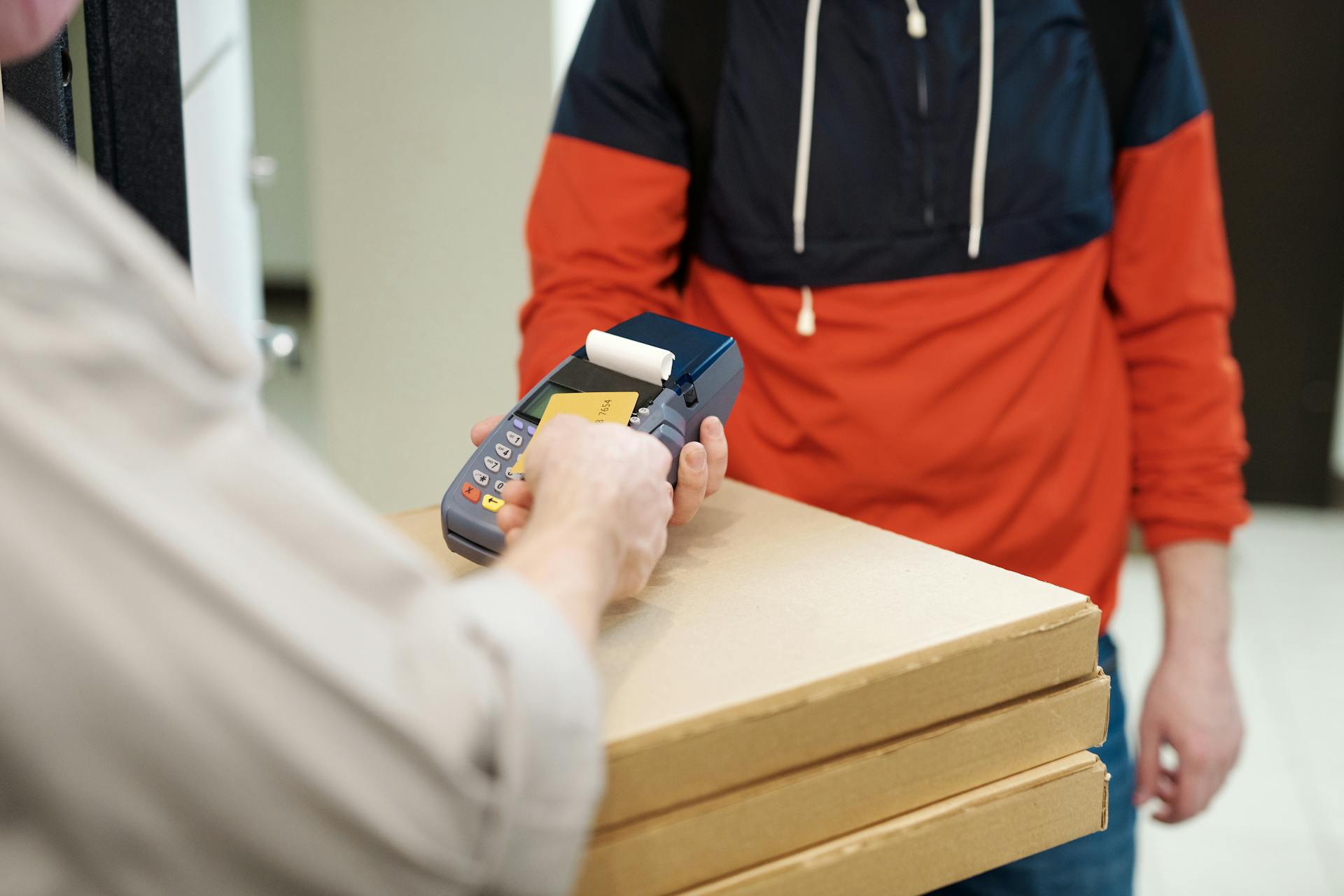
One of the most significant advantages of digital wallets is that they can improve financial services access, giving people in underserved areas more options for payment and commerce.
Digital wallets don't require a bank account at a physical bank, allowing you to place your funds in an online-only bank and providing access to financial services for unbanked and underbanked communities.
However, there are also some potential drawbacks to consider.
Not all vendors or stores accept mobile wallet payments, so you may not be able to use your digital wallet everywhere.
Setting up and using a digital wallet can be a bit tricky if you're not comfortable with technology.
If you lose your phone, your digital wallet may not be as secure if your phone isn't password protected and you don't have two-factor authentication enabled.
Here are some of the potential advantages and disadvantages of using a digital wallet:
- Virtual versions of credit cards, gift cards, and more
- Contactless payment options
- Quicker transactions
- Additional security features
And here are some of the potential disadvantages:
- Not always compatible or accepted
- Must know how to set up and use
- Increased security risk if you lose your phone
Are Safe?
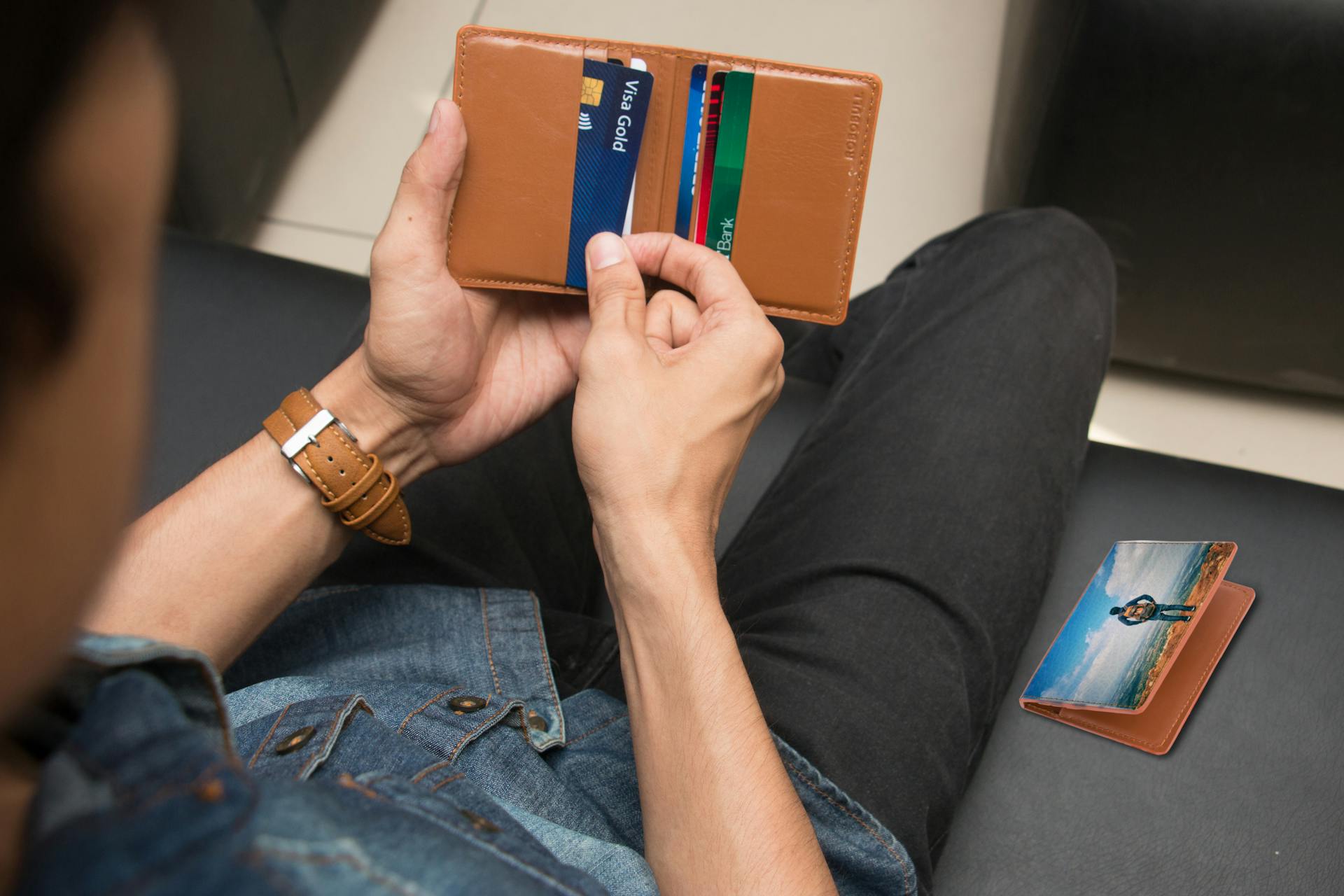
Digital wallets are a great way to make payments, but you might be wondering if they're safe. Tokenization is a key security feature that helps protect your card information by creating unique "tokens" associated with your credit card number.
These tokens are used instead of your actual card number, making it harder for fraudsters to access your financial information. You can think of it like a secret code that only you and the wallet know.
To add an extra layer of security, you can combine the safety features of the wallet with those of your phone or other devices. This includes two-factor authentication, Face ID, fingerprint ID, PINs, and screen locks.
Setting up fingerprint ID and password protection on your device can also help make it more secure, especially if you're worried about losing or having your device stolen.
To stay safe, it's essential to use strong passwords and change them regularly, monitor your accounts, and avoid making transactions on unsecured Wi-Fi networks.
Explore further: Four Corners Model for Payment Security
Getting Started
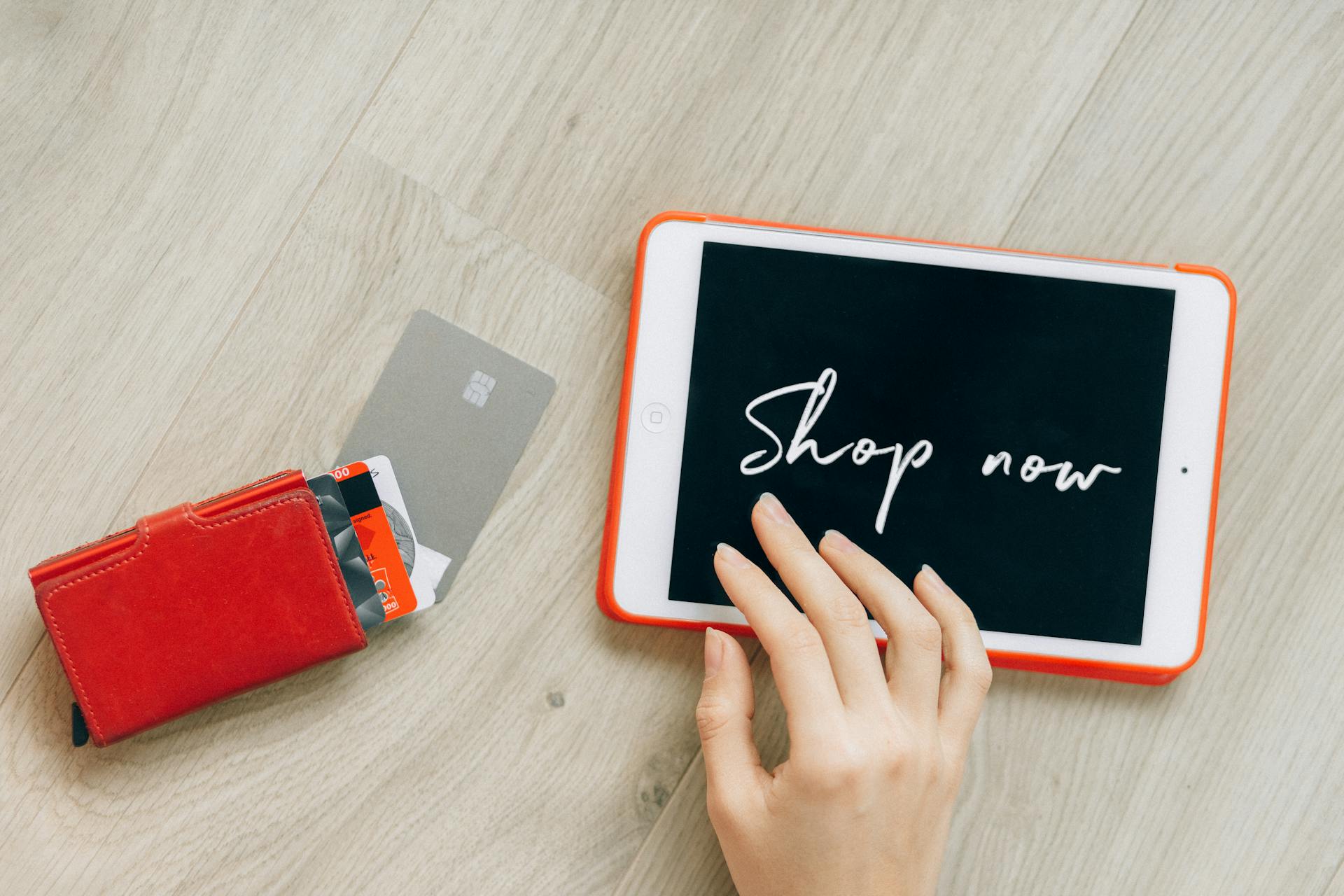
To use a credit card digital wallet, you'll need a smartphone with a secure internet connection. Most smartphones have the necessary technology to support digital wallets.
First, you'll need to choose a digital wallet service that's compatible with your credit card issuer. According to our article, some popular digital wallet services include Apple Pay, Google Pay, and Samsung Pay.
Do I Need?
Do I Need a Digital Wallet?
You don't necessarily need a digital wallet, but they offer a convenient way to pay for your purchases without carrying credit and debit cards.
Digital wallets securely store your payment information and passwords, making them a great option for those who want to reduce clutter and increase card security.
If you're always on the go, a digital wallet can be a lifesaver – you won't have to worry about losing your cards if you misplace them.
To get started with a digital wallet, you can add a card from your bank's app or website. Simply open your mobile banking app, log in to your account, and look for the "Add to GPay" button.
A fresh viewpoint: Carrier Billing T Mobile
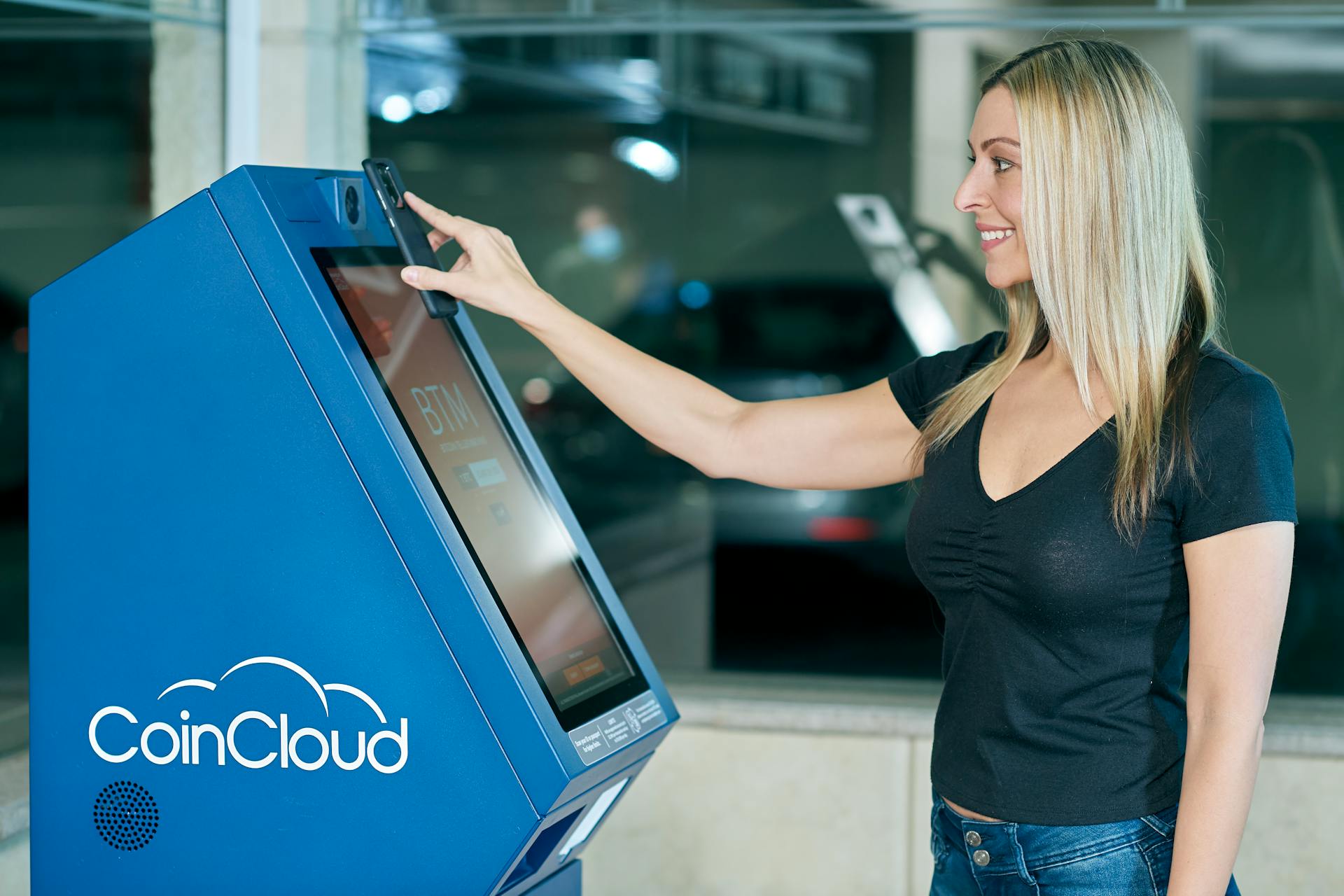
If you can't find this button, it's likely because your card or financial institution doesn't support this feature – in that case, contact your bank for more information.
Alternatively, you can add a card with the Google Wallet app. Open the app, tap "Add to Wallet", and follow the on-screen instructions to add a new credit or debit card.
Remember to read the Issuer Terms and accept them before adding your card.
Here are some popular digital wallets you might consider:
- Google Wallet
- Samsung Pay
- Apple Pay
- Coinbase Card
These options offer a range of features and benefits, so be sure to do your research and choose the one that best fits your needs.
Fix Issues
If your card can't be set up for tap and pay, check if your bank and card support payments with Google Wallet.
Try again later or use a different debit or credit card if your card is supported.
Check if your card was saved to your Google Account, not the Google Wallet app.
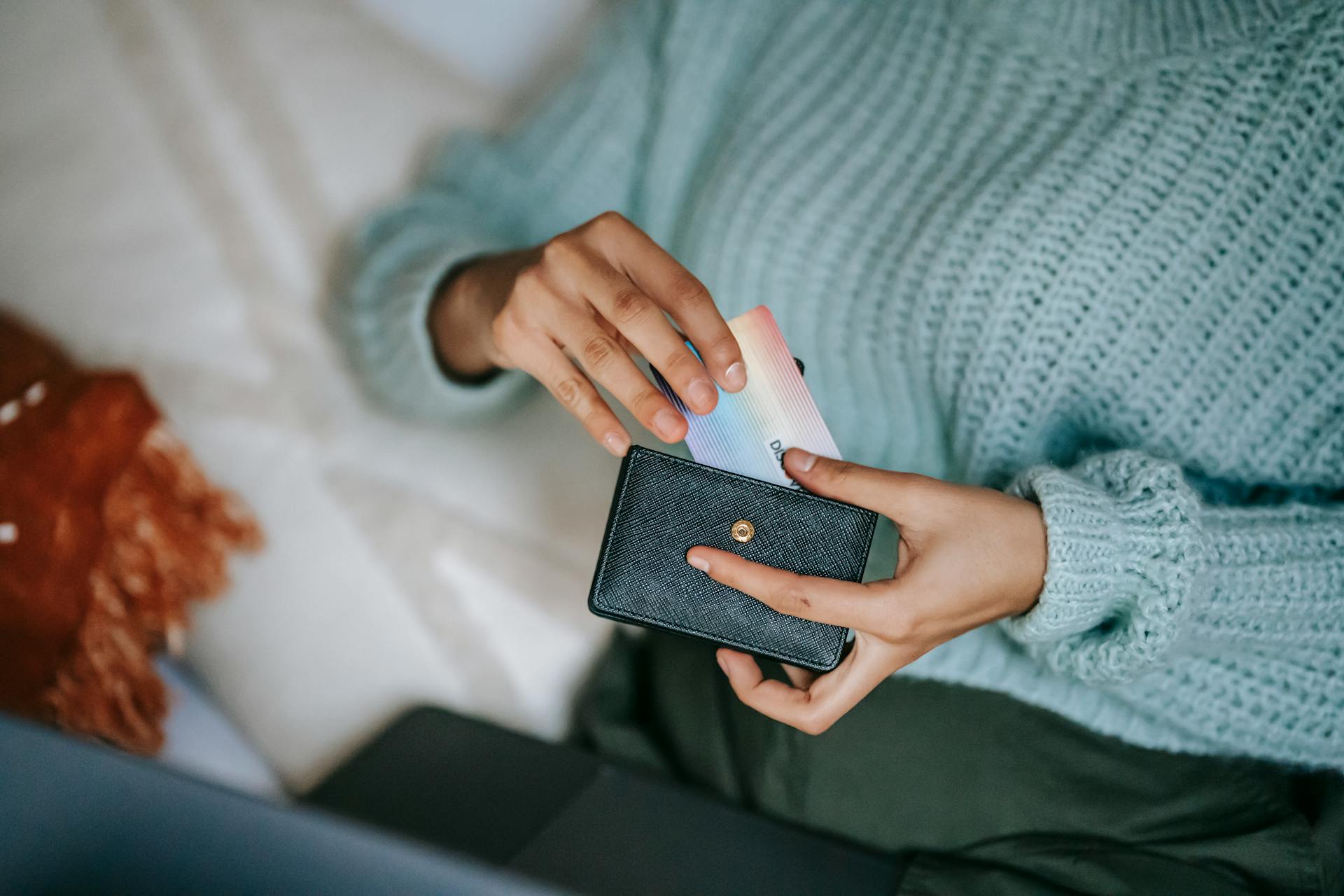
You can still use your card for certain purchases if it's saved to your Google Account.
Your phone may not support NFC technology, which is required for contactless payments.
Check if your phone meets the security standards for contactless payments.
If your cards are removed from Google Wallet as a security precaution, check if you've turned off screen lock or changed to a screen lock that Google Wallet doesn't support.
You may also need to re-add any removed cards to Google Wallet.
Here are some reasons your cards may have been removed:
- Turned off screen lock or changed to a screen lock that Google Wallet doesn’t support.
- Haven’t opened the Google Wallet app in 90 days or more.
- Factory reset your phone.
- Cleared all data from Google Play services or Google Wallet in your phone’s settings.
- Removed your Google Account from your phone.
- Remotely wiped or locked your device.
- Use Dual apps functionality on your device.
Return
If you're planning to return something, you'll want to know that digital wallets can store your payment information, which can be accessed on your desktop computer, laptop, or mobile device.
You can initiate a return through your digital wallet, and some digital wallets may allow you to request a refund directly through their platform.
Digital wallets can be accessed on multiple devices, not just your mobile device.
A unique perspective: Do Magnetic Wallets Ruin Credit Cards
Frequently Asked Questions
Can I put my credit card in my phone wallet?
Yes, you can add your credit card to your phone's digital wallet using the Google Wallet app. Simply open the app and follow the prompts to add a new card using your camera or manually entering details.
Can I use my credit card without the physical card?
Yes, you can make purchases without your physical credit card using a virtual credit card or digital wallet. Some credit card issuers allow immediate access to your account once you're approved.
Featured Images: pexels.com
